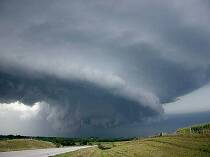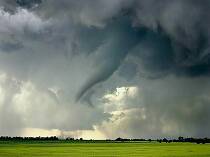The sky undergoes many transformations during the course of a day. Cumulous gives way to nimbus, bright light quickly turns diffuse and gray. Lightning and thunder reign, then minutes later the sky clears. The day ends with the colorful fanfare of a setting sun. Atmospheric changes like these make excellent photographic opportunities. You need only have your camera ready to take advantage of them.

This fantastic storm photo was captured by
ACD Newsletters subscriber Robert Broome of Waikiki, WA, USA.
More than anything else, shooting storms and sunsets is about being at the right place at the right time. That’s why it’s so important to bring your camera along when you go out. The most amazing visuals will present themselves when you least expect it.
Case in point: About a year ago your narrator was cruising down a lonely stretch of highway in Northern Ontario when a “sundog” appeared (a brilliant luminescent effect that’s caused by sunlight reflecting off tiny ice crystals in the atmosphere). And of course, the digital camera was nowhere to be found.
Storm Clouds
Shooting storm clouds is a great place to start because the sky changes so quickly. It gives you the opportunity to shoot a range of atmospherics in a short period of time. Just zoom in on the area of the sky you want to capture, and shoot away.

Here is another great storm photo by
Robert Broome of Waikiki, WA, USA.
The only things you should be careful of are camera shake in low-lighting, and bright shafts of sunlight that wash out the details of the clouds. Adjust your camera’s exposure compensation to make the picture a little darker. This will prevent overexposure and loss of detail. Also, use bracketed exposure so you can choose the best from a number of photos at the end of your session.
The ultimate achievement is capturing lightning on camera. Doing so is a very difficult task because of it’s unpredictability. Remain poised, with your camera focused on an area you think will or has already generated bolts of lightning. It’s recommend that you use an ISO of around 100 when trying to capture this unique atmospheric, and an aperture of F8 for close up lightning, F2.5 from further away.
And don’t forget to hang around for that lovely rainbow.
Sunsets
As with storms, it helps to underexpose sunsets to get a richer, darker color that accentuates texture. This is especially effective with skies that are red, pink, or purple. Almost all great shots of sunsets include clouds, and/or atmospheric dust (which can result from pollution or volcanic ash in the air). Both refract sunlight, making for more intense visual scenes. Just be careful not too focus directly on the sun when it is still very bright, intense, and high in the sky. You might end up damaging your eyes and your camera’s CCD.

Notice how the photographer has waited till
just the right moment and caught this beautiful
scene highlighted by the homeward-cruising
hawk. Photo by Carol Canady.
People generally love to shoot sunsets and sunrises from the beach because it gives them an unobstructed view of the horizon. You can also shoot the same subject from mountaintops and high-rise buildings; it just depends on where you are, and what sort of visual effect you want to create.
If you’d like to add context to your photos, make sure there is an object in the foreground to give the sky you’re shooting more depth and perspective. Bridges, buildings, boats and people are excellent for this purpose. Chances are that foreground images will appear as powerful silhouettes in your pictures.
A few more things to remember:
- Keep shooting after the sun has gone down. The light that fills the sky at this time is soft and warm, losing the harsh quality resulting from direct sunlight, and giving your pictures a heavenly glow.
- When shooting atmospherics you should turn off the white balance feature on your camera. This way the camera won’t compensate for vivid colors by washing them out.
- Switch your camera to landscape mode. Doing this sets the lens to infinity and ensures sharply focused pictures.

Photo by Don Munro of Calgary, Alberta, Canada.
Credits
Republished with the permission of ACD Systems, makers of ACDSee image management software
by Brenden Joel Reid

Leave a Reply